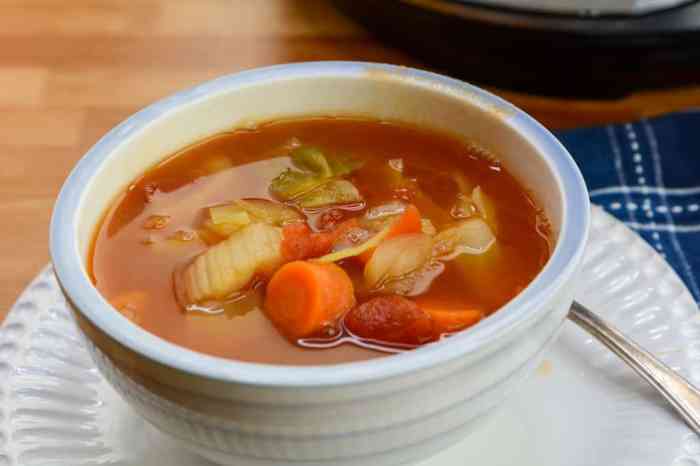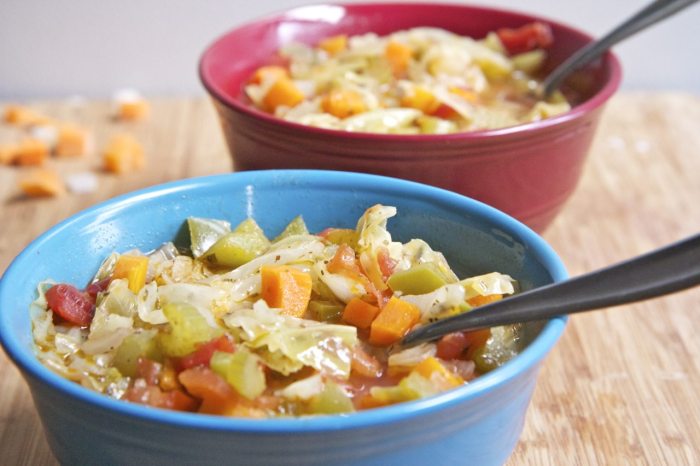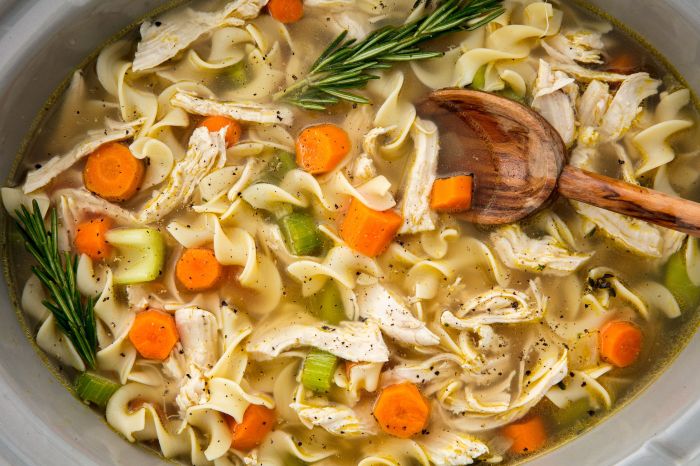Nutritional Aspects of Cabbage Soup for Weight Loss

Source: adventuresofanurse.com
Cabbage soup for weight loss recipes – Cabbage soup’s popularity as a weight-loss aid stems largely from its nutritional profile. It’s a low-calorie, high-volume food that promotes satiety, making it easier to stick to a calorie deficit. This, combined with the essential vitamins and minerals present in cabbage and other potential soup ingredients, makes it a potentially beneficial component of a weight-loss plan.
Cabbage’s Nutritional Composition
Cabbage is an excellent source of various nutrients vital for overall health and well-being. It’s particularly rich in vitamins C and K, as well as folate and fiber. These nutrients play crucial roles in various bodily functions, contributing to both short-term weight management and long-term health. Specifically, vitamin C acts as an antioxidant, protecting cells from damage, while vitamin K is essential for blood clotting.
Folate is crucial for cell growth and development, and dietary fiber aids digestion and promotes feelings of fullness. The mineral content of cabbage includes potassium, which helps regulate blood pressure, and manganese, which supports bone health and metabolism.
The Role of Low Calories and High Fiber in Weight Loss
Cabbage’s low-calorie density is a key factor in its weight-loss benefits. A cup of chopped cabbage contains only about 22 calories, meaning you can consume a significant volume without exceeding your daily calorie limit. This high volume contributes to satiety, helping to curb hunger and reduce overall calorie intake. Furthermore, the high fiber content in cabbage adds to this effect.
Fiber is indigestible, meaning it adds bulk to the stool and promotes feelings of fullness, reducing the likelihood of overeating. This combination of low calories and high fiber makes cabbage an ideal ingredient for weight-loss strategies.
Comparison to Other Weight-Loss Diets
Compared to other popular weight-loss diets, cabbage soup offers a relatively low-calorie and nutrient-rich approach. While some restrictive diets may lack essential vitamins and minerals, a well-formulated cabbage soup recipe can provide a balanced intake of nutrients. However, it’s crucial to remember that relying solely on cabbage soup for weight loss is unsustainable in the long term and could lead to nutritional deficiencies.
A balanced approach that incorporates cabbage soup as part of a broader, healthy diet is more effective and sustainable for achieving and maintaining weight loss.
Nutritional Comparison of Cabbage Soup Variations
The nutritional profile of cabbage soup can be significantly altered by adding different ingredients. Below is a comparison of various variations, illustrating the impact of added vegetables and lean proteins. Remember these are approximate values and can vary based on specific ingredients and portion sizes.
| Soup Variation | Calories (per serving) | Protein (grams) | Fiber (grams) |
|---|---|---|---|
| Basic Cabbage Soup | 150 | 5 | 8 |
| Cabbage Soup with Chicken Breast | 200 | 25 | 7 |
| Cabbage Soup with Beans and Carrots | 180 | 10 | 12 |
| Cabbage Soup with Beef and Green Beans | 220 | 30 | 9 |
Popular Cabbage Soup Recipes for Weight Loss
Cabbage soup has become a popular choice for those looking to shed extra pounds due to its low-calorie nature and high fiber content. Its versatility allows for a wide range of recipes, catering to different tastes and culinary skills. The following recipes offer varying levels of complexity and ingredient lists, ensuring there’s an option for everyone.
Simple Cabbage Soup
This recipe is perfect for beginners and those short on time. It focuses on basic ingredients and a straightforward preparation method, resulting in a hearty and flavorful soup.
- Ingredients: 1 small onion, chopped; 2 cloves garlic, minced; 1 medium head of cabbage, chopped; 4 cups vegetable broth; 1 (14.5 ounce) can diced tomatoes, undrained; 1 teaspoon dried oregano; salt and pepper to taste.
- Instructions:
- Sauté onion and garlic in a large pot until softened (about 5 minutes).
- Add cabbage, vegetable broth, diced tomatoes, and oregano. Bring to a boil.
- Reduce heat and simmer for 20-25 minutes, or until cabbage is tender.
- Season with salt and pepper to taste.
Hearty Cabbage and Sausage Soup
This recipe adds a protein boost with sausage, creating a more filling and satisfying soup. While slightly more complex, the additional ingredients enhance the overall flavor profile.
- Ingredients: 1 pound Italian sausage, casings removed; 1 onion, chopped; 2 carrots, chopped; 2 celery stalks, chopped; 1 medium head of cabbage, chopped; 6 cups vegetable broth; 1 (14.5 ounce) can diced tomatoes, undrained; 1 teaspoon dried basil; 1/2 teaspoon dried thyme; salt and pepper to taste.
- Instructions:
- Brown sausage in a large pot over medium heat, breaking it up with a spoon. Remove sausage and set aside.
- Add onion, carrots, and celery to the pot and sauté until softened (about 5 minutes).
- Add cabbage, vegetable broth, diced tomatoes, basil, and thyme. Bring to a boil.
- Return sausage to the pot. Reduce heat and simmer for 30-35 minutes, or until cabbage is tender.
- Season with salt and pepper to taste.
Spicy Cabbage and Bean Soup, Cabbage soup for weight loss recipes
This recipe introduces beans and spices for a heartier, more flavorful, and slightly spicier soup. It’s ideal for those seeking a more complex and exciting culinary experience.
- Ingredients: 1 onion, chopped; 2 cloves garlic, minced; 1 green bell pepper, chopped; 1 red bell pepper, chopped; 1 (15 ounce) can kidney beans, rinsed and drained; 1 (15 ounce) can black beans, rinsed and drained; 1 medium head of cabbage, chopped; 6 cups vegetable broth; 1 teaspoon chili powder; 1/2 teaspoon cumin; 1/4 teaspoon cayenne pepper (optional); salt and pepper to taste.
- Instructions:
- Sauté onion, garlic, and bell peppers in a large pot until softened (about 5 minutes).
- Add kidney beans, black beans, cabbage, vegetable broth, chili powder, cumin, and cayenne pepper (if using). Bring to a boil.
- Reduce heat and simmer for 35-40 minutes, or until cabbage and beans are tender.
- Season with salt and pepper to taste.
Recipe Summary
| Recipe | Key Ingredients | Approximate Calories per Serving (1 cup) | Preparation Time |
|---|---|---|---|
| Simple Cabbage Soup | Cabbage, onion, garlic, vegetable broth, diced tomatoes | ~80-100 | 30 minutes |
| Hearty Cabbage and Sausage Soup | Cabbage, sausage, onion, carrots, celery, vegetable broth, diced tomatoes | ~150-180 | 45 minutes |
| Spicy Cabbage and Bean Soup | Cabbage, kidney beans, black beans, onion, bell peppers, vegetable broth, chili powder, cumin | ~120-150 | 45-50 minutes |
Health Benefits Beyond Weight Loss
Cabbage, often lauded for its role in weight loss diets, offers a wealth of health benefits extending far beyond its slimming properties. Its nutritional profile contributes to improved digestion, reduced inflammation, and overall better health. Understanding these benefits can encourage a more holistic appreciation for incorporating cabbage into a balanced diet.Cabbage’s nutritional power stems from its rich content of vitamins, minerals, and antioxidants.
These components work synergistically to promote various physiological processes, contributing to a healthier body.
Many find cabbage soup a helpful component of weight loss diets, due to its low calorie count and high fiber content. For a flavorful, alternative low-calorie soup option, consider trying a creamy and satisfying butternut squash and coconut milk soup recipe ; it’s surprisingly filling and delicious. Returning to cabbage soup, remember to experiment with different spices and vegetables to keep your weight loss journey interesting and enjoyable.
Nutritional Components and Their Roles
Cabbage is a nutritional powerhouse, boasting significant amounts of vitamin C, vitamin K, folate, and various antioxidants. Vitamin C, a potent antioxidant, supports the immune system and protects cells from damage caused by free radicals. Vitamin K plays a crucial role in blood clotting and bone health. Folate is essential for cell growth and development, particularly important during pregnancy.
The various antioxidants present in cabbage help combat oxidative stress, a process linked to aging and chronic diseases. Furthermore, cabbage is a good source of fiber, promoting healthy digestion and preventing constipation. The sulfur-containing compounds in cabbage contribute to its anti-inflammatory properties.
Cabbage Soup Compared to Other Vegetable Soups
While many vegetable soups offer health benefits, cabbage soup stands out due to its specific nutrient profile. For instance, compared to a tomato-based soup, cabbage soup might offer a higher concentration of vitamin K and fiber. Compared to a potato-based soup, cabbage soup would likely be lower in calories and carbohydrates, making it a more suitable choice for weight management.
The type and combination of vegetables in any soup significantly impact its nutritional value. A soup rich in cruciferous vegetables, like cabbage, broccoli, and cauliflower, will provide a unique blend of vitamins, minerals, and beneficial compounds.
Potential Health Benefits and Mechanisms
The numerous health benefits associated with cabbage consumption can be attributed to its unique nutritional composition. Below is a summary:
- Improved Digestion: The high fiber content in cabbage promotes regular bowel movements and prevents constipation. Fiber also acts as a prebiotic, feeding beneficial gut bacteria and improving gut health.
- Reduced Inflammation: Antioxidants and sulfur-containing compounds in cabbage possess anti-inflammatory properties, helping to reduce chronic inflammation linked to various diseases.
- Enhanced Immune Function: Vitamin C and other antioxidants in cabbage strengthen the immune system, protecting against infections and illnesses.
- Improved Cardiovascular Health: Certain compounds in cabbage may contribute to lowering cholesterol levels and blood pressure, promoting heart health. This is supported by observational studies showing correlations between cruciferous vegetable consumption and lower risk of cardiovascular disease.
- Cancer Prevention: Some research suggests that the antioxidants and other bioactive compounds in cabbage may offer protection against certain types of cancer. This is a complex area of ongoing research, and more studies are needed to establish definitive conclusions.
Potential Drawbacks and Considerations: Cabbage Soup For Weight Loss Recipes
While cabbage soup diets can contribute to initial weight loss, relying solely on this approach presents several potential drawbacks. It’s crucial to understand these limitations and implement strategies to mitigate any negative health consequences. A sustainable weight loss journey necessitates a holistic approach incorporating balanced nutrition and regular physical activity.
The primary concern with cabbage soup diets is the potential for nutritional deficiencies. Cabbage, while nutritious, doesn’t provide the full spectrum of vitamins, minerals, and macronutrients (proteins, carbohydrates, and fats) required for optimal health. Restricting your diet to primarily cabbage soup for an extended period can lead to fatigue, weakness, and other adverse effects stemming from inadequate nutrient intake.
Nutrient Deficiencies and Imbalances
Restricting dietary intake to a single food source, even a healthy one like cabbage, dramatically limits the variety of nutrients your body receives. This can result in deficiencies in essential vitamins and minerals like iron, calcium, vitamin D, and B vitamins. These deficiencies can manifest as fatigue, weakness, impaired immune function, and even more serious health complications over time.
For example, a prolonged lack of iron can lead to anemia, characterized by fatigue and shortness of breath. Similarly, insufficient calcium can negatively impact bone health.
The Importance of a Balanced Diet and Exercise
Sustainable weight loss isn’t solely about restricting calories; it’s about creating a healthy and balanced lifestyle. While cabbage soup can be a part of a weight-loss plan, it shouldn’t be the only component. A balanced diet incorporating a variety of fruits, vegetables, lean proteins, and whole grains provides the essential nutrients your body needs to function optimally and maintain energy levels throughout the weight loss process.
Regular exercise, such as cardio and strength training, further enhances weight loss by increasing metabolism and building muscle mass.
Mitigating Drawbacks Through Dietary Diversification
To mitigate the risks associated with restrictive cabbage soup diets, it’s essential to gradually incorporate other nutrient-rich foods. Start by adding small portions of lean protein sources, such as chicken breast or fish, to your meals. Then, include a variety of colorful vegetables and fruits to ensure you are getting a broad range of vitamins and minerals. Whole grains, such as brown rice or quinoa, can provide essential fiber and carbohydrates for sustained energy.
Remember to consult a registered dietitian or healthcare professional for personalized dietary guidance.
Strategies for Mitigation
| Potential Drawback | Mitigation Strategy |
|---|---|
| Nutrient deficiencies (e.g., iron, calcium, vitamin D) | Incorporate a variety of fruits, vegetables, lean proteins, and whole grains into your diet. Consider taking a multivitamin supplement after consulting your doctor. |
| Lack of fiber | Include high-fiber foods like whole grains, legumes, and other vegetables alongside cabbage soup. |
| Monotonous diet leading to decreased adherence | Introduce variety by adding other healthy soups, salads, and light meals incorporating cabbage as one ingredient. |
| Potential for digestive discomfort | Introduce cabbage gradually into your diet to allow your digestive system to adapt. Ensure adequate hydration. |
| Unsustainable long-term weight loss | Combine cabbage soup with a balanced diet and regular exercise for sustainable weight management. |
Visual Representation of Cabbage Soup Recipes

Source: divascancook.com
A visually appealing bowl of cabbage soup can significantly enhance its appeal and encourage consumption, especially within a weight-loss context where maintaining motivation is crucial. The right presentation can transform a simple, healthy meal into a satisfying and enjoyable experience. This section explores the visual aspects of various cabbage soup recipes, highlighting elements that contribute to their attractiveness.The visual impact of cabbage soup hinges on a balance of color, texture, and ingredient visibility.
Imagine a vibrant bowl: a rich, emerald green from the cabbage dominates, punctuated by the deep red of diced tomatoes or the sunny yellow of carrots. Small flecks of herbs, perhaps parsley or dill, add a textural contrast and a pop of fresh green. Tender pieces of chicken or lean beef, if included, provide visual interest and suggest heartiness.
The broth itself should be clear and inviting, not cloudy or greasy. The overall impression should be one of freshness and wholesome goodness.
Visual Appeal of Different Cabbage Soup Variations
The visual appeal of cabbage soup varies considerably depending on the included ingredients. A simple cabbage and vegetable soup will have a more muted palette compared to a heartier version with added beans or meat. For example, a vegetarian version featuring vibrant green cabbage, orange carrots, and yellow squash offers a bright and cheerful appearance. In contrast, a soup with added kidney beans introduces a darker, richer hue and a more substantial texture.
The addition of lean ground beef or shredded chicken adds visual depth and complexity, with the meat providing contrasting browns and textures amidst the greens and yellows of the vegetables. Variations with added spices like turmeric can introduce warm, golden tones, while the addition of fresh herbs like cilantro or chives provides a bright, contrasting color and appealing textural element.
Visual Elements Enhancing Cabbage Soup Appeal
Several visual elements can significantly enhance the attractiveness of cabbage soup. Properly diced vegetables, ensuring consistent size and shape, creates a neat and appealing appearance. Avoid overly large or unevenly cut pieces. The use of a wide, shallow bowl allows for better visibility of the ingredients and their colors, making the soup appear more inviting. Garnishing with fresh herbs, a swirl of cream (in moderation), or a sprinkle of grated cheese can add a touch of elegance and visual interest.
A simple presentation, perhaps with a crusty bread roll alongside, can elevate the overall aesthetic. Furthermore, plating the soup in a stylish bowl or serving it in individual ramekins can further enhance its visual appeal and make it more appealing for consumption.
Essential Questionnaire
Can I eat only cabbage soup for weight loss?
While cabbage soup can aid weight loss, relying solely on it is not recommended due to potential nutrient deficiencies. A balanced diet is crucial.
How long can I safely consume cabbage soup as part of a weight loss plan?
Consult your doctor or a registered dietitian to determine a safe and appropriate duration. Generally, short-term use as part of a balanced approach is preferable.
Are there any side effects associated with consuming large quantities of cabbage soup?
Excessive cabbage consumption might lead to gas or digestive discomfort. Start with smaller portions and increase gradually.
Can I adapt the recipes to suit my dietary needs (e.g., vegetarian, vegan)?
Absolutely! Many variations are possible. Feel free to substitute ingredients to fit your dietary preferences and restrictions.


